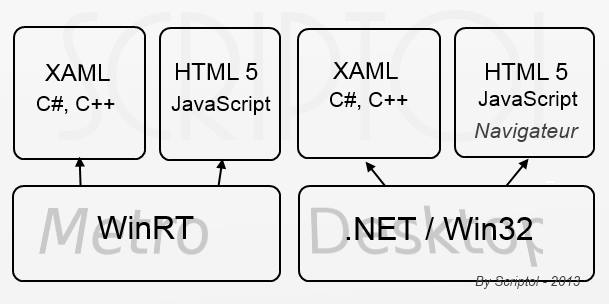XAML, GUI language
XAML greatly facilitates the creation, editing, reuse of graphical user interfaces for web applications or local applications.
It was in Windows that XUL in Firefox, FXML in JavaFX, but while XUL tends to disappear, XAML has been spreading to all systems since .NET became open and portable.
You can even use XAML in a web page with the Granular framework that implements the WPF backend.
XAML stands for "Extensible Application Markup Language," that is, an extensible application tag language. The meaning actually changed over time, originally WPF's code name, "Avalon," being part of the acronym. It is an XML format with semantics that match the description of the GUI.
It was created by Microsoft, which was apparently based on Mozilla's XUL, and the rendering and formatting engine requires the .NET environment in Seven and WinRT in Windows 8.

This diagram shows XAML in Windows 8.
Both on the classic desktop with .NET and in Modern UI for immersive applications.
Microsoft created a browser plugin developed as an alternative to Flash, Silverlight, which allows XAML to be rotated in any browser. However, its development was discontinued, as HTML 5 with the Canvas tag and augmented with SVG provides most of the Silverlight features, making the latter redundant. However, XAML remains an alternative to HTML 5 for immersive applications in Windows 8.
Originally designed to create applications on the Vista WPF platform, XAML will actually only integrate into Windows with version 8.
In fact, it has the ability to describe the user interface much easier than HTML, but is limited to Windows-specific applications, while HTML is a universal standard.
For more information on changing orientation at Microsoft, see What's the Future for XAML.
XAML describes interface objects with their presentation
It is easier to implement applications with XAML than with XUL or any other tag language using CSS, since presentation data are tag attributes. But then it will be more difficult to change the presentation or create a multiple view.
Here are other characteristics:
- XAML code is compiled in an intermediate language .
- XAML elements and properties have a direct equivalent in the .NET class library as nested classes and attributes.
- Uses vector graphics.
- Ability to use .NET classes from XAML.
- The ability to insert C # code with the "code" tag or use JavaScript. (XUL, HTML use JavaScript).
- Events (such as a mouse click) are tag properties, and tags are interface elements.
Two examples of XAML code...
Show: Greetings to the world:
<Page xmlns="">
<TextBlock>
Salut, le Monde!
</TextBlock>
</Page>
Drawing button:
<button
Background="Gray"
FontSize="18pt"
Click="OnClick">
Soumettre
</button>
See also Comparing XAML and HTML 5, and the main graphical user interface languages.
The WPF-inspired Avalonia framework works with .NET on all systems and uses XAML as its interface language.
